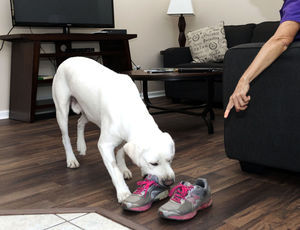 Can veterans with post-traumatic stress disorder (PTSD) benefit from warm hearts, cold noses and waggy tails?
Can veterans with post-traumatic stress disorder (PTSD) benefit from warm hearts, cold noses and waggy tails?
K2 Solutions is wrapping up the first year of its involvement in a U.S. Department of Veteran Affairs research project to determine if service or emotional support dogs are the answer.
“The VA wants to measure effectiveness,” said Eric Babin, a senior trainer at K2’s training facility in Derby. “They don’t haveany data, although it’s common knowledge that dogs help veterans. It comes down to picking the right dog for the veteran.”
While there is strong anecdotal evidence that such dogs help veterans, there is little evidence-based measurement of their effectiveness. Research and data are scant, which is one reason the VA is cautious about the use of dogs for individuals suffering from combat stress.
Currently, the VA provides service dogs only for veterans with certain physical disabilities, such as vision or hearing loss, or the loss of a limb. The findings of the new study could potentially change that policy because the goals include finding answers and building consensus.
“The study will make an important contribution to the literature on the use of service animals for those with mental health diagnoses,” Patricia Dorn, director of VA Rehabilitation Research and Development, said in a statement.
Half of the veterans in the study will be assigned a service dog, while the others will get an emotional support dog.
Paul Bunker, project manager for Southern Pines-based K2 Solutions, said the difference between the two is a matter of training — five months for a service dog and one to two months for an emotional support dog.
“Service dogs can do tasks such as turning on a light, picking up an object, or using an ATM,” Bunker said. “An emotional support dog has a very limited capability task-wise. It’s there to offer support in an emotional crisis. It gives the veteran an outlet to take their mind off things. Even petting a dog can reduce stress.”
Bunker said K2 trained four service dogs and four emotional support dogs in Phase I of a contract awarded last year to K2 and the Armed Forces Foundation (AFF).
“Three of the dogs have already been placed with veterans,” he said. “We’ll train 18 more dogs in Phase II, which ends next April.”
K2 has more heavily pursued opportunities to train dogs for veterans, as well as canines for domestic law enforcement, since the military last December ended a series of contracts started in 2009. Under those contracts, K2 trained dogs for the U.S. Marines and U.S. Army to detect Improvised Explosive Devices (IEDs) throughout the world while keeping the soldier a safe distance away.
Lane Kjellsen, founder and CEO of K2, said the company is forming a nonprofit to enhance its service dog program.
“The industry is designed around nonprofits,” Kjellsen said. “Most people cannot afford these dogs commercially because it’s very expensive to train them. Most are provided based on donations. We’ll have the nonprofit up and running by the end of the year.”
Kjellsen said sourcing the dogs — mainly labrador retrievers, golden retrievers and German shepherds — is difficult.
“It’s really a challenge,” he said. “We’re always procuring dogs.”
K2 has also launched a volunteer foster family program to house the dogs while they are being trained.
“We need the dogs raised in homes to be social and obedient,” he said.
The majority of the training will occur in Derby, one of three sites across the country being utilized for the study.
Babin recently demonstrated the “block” and “behind” commands that tell a dog to stand in front of or behind a veteran.
“That’s a big one,” he said. “It gives the veteran a sense of security that someone’s got their back. The dog gives them a buffer.”
The female golden retriever Babin was training received a treat each time she successfully completed the task.
“They certainly are a lot of fun to train,” he said. “An emotional support dog is everything a service dog is. The only difference is they don’t do the tasks.”
Babin said K2 has seen “a big change” in the veterans placed with their dogs.
“Smoking lessens, sleeping gets better, they go out in public more and they start to exercise again,” he said.
Babin added that K2 takes a measured approach when a veteran and dog are paired for the first time.
“It’s very structured,” he said. “You have to be careful. You can’t overwhelm the veteran with information. You can’t throw it all at them at once.”
Researchers hope the study will prove that service and emotional support dogs mitigate PTDS symptoms such as re-experiencing, emotional numbing and social isolation.
Kelly Skelton, a psychiatrist who is overseeing the study at the Atlanta VA, said the dogs may be a way to help therapy kick in and achieve its aims.
“We hope that eventually some of the specific (service dog) tasks won’t be required as much,” Skelton said. “(The veteran) won’t need … someone watching their back all the time.”
Skelton added that the theory is that the dogs “can serve as a bridge” to get veterans past their initial fear.
“That way, they can get out more and engage in therapy so they can eventually free themselves of that excessive fear response,” she said.
Babin agreed, saying, “The ultimate goal is for a veteran to get back into life and not need the dog in public.”
Contact Ted M. Natt Jr. at (910) 693-2474 or tnatt@thepilot.com.
http://www.thepilot.com/business/building-buddies-k-s-service-dogs-to-support-veterans-mental/article_37d47370-0c95-11e5-9e47-83492dc06874.html

